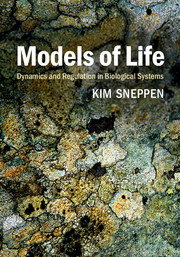Book contents
- Frontmatter
- Contents
- Preface
- 1 Life from a physics perspective
- 2 E. coli as a model system
- 3 Dynamics of regulatory links
- 4 Statistical mechanics of phage λ
- 5 Diffusion and randomness in transcription
- 6 Stochastic genes and persistent decisions
- 7 cis-Acting gene regulation and epigenetics
- 8 Feedback circuits
- 9 Networks
- 10 Signaling and metabolic networks
- 11 Agent-based models of signaling and selection
- 12 Competition and diversity
- 13 Evolution and extinction
- Appendix
- References
- Index
1 - Life from a physics perspective
Published online by Cambridge University Press: 05 October 2014
- Frontmatter
- Contents
- Preface
- 1 Life from a physics perspective
- 2 E. coli as a model system
- 3 Dynamics of regulatory links
- 4 Statistical mechanics of phage λ
- 5 Diffusion and randomness in transcription
- 6 Stochastic genes and persistent decisions
- 7 cis-Acting gene regulation and epigenetics
- 8 Feedback circuits
- 9 Networks
- 10 Signaling and metabolic networks
- 11 Agent-based models of signaling and selection
- 12 Competition and diversity
- 13 Evolution and extinction
- Appendix
- References
- Index
Summary
In this first chapter we review some basic concepts of organization and dynamics in living systems, with emphasis on what makes them different from systems that one normally studies with the tools of physics. Subsequent chapters use model systems to illustrate how interactions between proteins, metabolites and DNA govern strategic decisions on the scales ranging from a living cell, to organisms to populations.
Life has provided scientists with a vast number of stories [1–9] reflecting facets of the dynamic interplay between material and memory, an interplay that is formed by dynamical processes from the noise on the molecular scale, to the exceptionally long memory of replicating DNA, to the exponential growth of populations [10, 11].
In short, life is self-reproducing, persistent and robust (we are nearly 4 billion years old). Living systems are open systems that have “memorized” how to channel energy into self-reproducing networks. Living cells are complex (after all more than 1000 different types of molecules are needed to make even the simplest cell work), “more” than the sum of its parts (arbitrarily dividing an organism kills it). Life harvests energy and it evolves. The essential processes for the workings of life take place from the scale of a single water molecule to balancing the atmosphere of the entire planet [7, 12].
Biology has provided us with some fundamental/universal mechanisms that one meets in various disguises and variations [13].
- Type
- Chapter
- Information
- Models of LifeDynamics and Regulation in Biological Systems, pp. 1 - 16Publisher: Cambridge University PressPrint publication year: 2014



